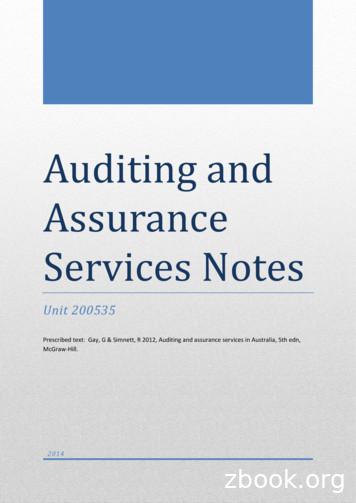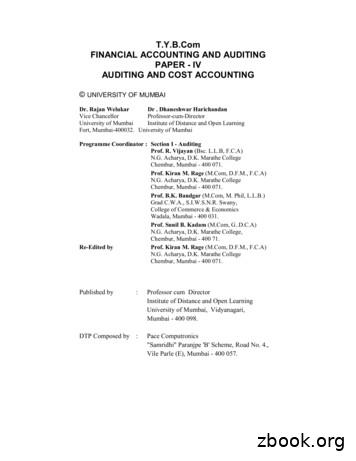Auditing And Assurance Services 17th Edition Arens Test Bank
Auditing and Assurance Services 17th Edition Arens Test BankFull Download: iting and Assurance Services, 17e (Arens/Elder/Beasley)Chapter 1 The Demand for Audit and Other Assurance Services1.1 Learning Objective 1-11) In the auditing process,A) the types and amounts of evidence remain constant from audit to audit.B) the criteria for evaluating information will not vary depending on the information beingaudited.C) the audit report communicates the auditor's findings to users.D) records are gathered by the auditor to determine whether the audited information is stated inaccordance with SEC standards.Answer: CTerms: Audit processDifficulty: ModerateObjective: LO 1-1AACSB: Reflective thinking2) Which of the following is considered audit evidence?A)Oral statementsWrittenAuditormade by managementCommunicationsObservationsYNNB)Oral statementsmade by enCommunicationsNAuditorObservationsYC)Oral statementsmade by managementYD)Oral statementsmade by managementNAnswer: CTerms: Audit evidenceDifficulty: EasyObjective: LO 1-1AACSB: Reflective thinking1Copyright 2020 Pearson Education, Inc.This sample only, Download all chapters at: AlibabaDownload.com
3) Which of the following can be used as a criterion for evaluating information being audited?A) International Financial Reporting Standards (IFRS)B) Generally Accepted Accounting Principles (GAAP)C) Internal Revenue Code (IRC)D) all of the aboveAnswer: DTerms: Criteria by which an auditor evaluates informationDifficulty: ModerateObjective: LO 1-1AACSB: Reflective thinking4) Auditors do not provide which of the following?A) assurance on financial statementsB) assurance on the effectiveness of internal controls over financial reportingC) assurance on corporate sustainability reportsD) absolute assurance on the financial statements including assuming responsibility for themAnswer: DTerms: Nature of Objectives of AuditingDifficulty: ModerateObjective: LO 1-1AACSB: Reflective thinking5) The accumulation and evaluation of evidence about information to determine and report onthe degree of correspondence between the information and some established criteria is defined asA) accounting.B) financial reporting.C) tax reporting.D) auditing.Answer: DTerms: Definition of auditingDifficulty: ModerateObjective: LO 1-1AACSB: Reflective thinking6) The criteria by which an auditor evaluates the information under audit may vary with theinformation being audited.Answer: TRUETerms: Criteria by which an auditor evaluates informationDifficulty: EasyObjective: LO 1-1AACSB: Reflective thinking2Copyright 2020 Pearson Education, Inc.
7) One criterion used by an external auditor to evaluate published financial statements is knownas generally accepted auditing standards.Answer: FALSETerms: Criteria used by external auditor to evaluate published financial statementsDifficulty: EasyObjective: LO 1-1AACSB: Reflective thinking8) Auditors strive to maintain a high level of independence to keep the confidence of usersrelying on their reports.Answer: TRUETerms: IndependenceDifficulty: EasyObjective: LO 1-1AACSB: Reflective thinking9) To perform an audit, there must be information in a verifiable form and some criteria bywhich the auditor can evaluate the information.Answer: TRUETerms: IndependenceDifficulty: EasyObjective: LO 1-1AACSB: Reflective thinking10) An auditor must be competent and have an independent mental attitude.Answer: TRUETerms: Criteria used by external auditor to evaluate published financial statementsDifficulty: EasyObjective: LO 1-1AACSB: Reflective thinking11) Auditors are not allowed and should not audit subjective information like the effectivenessof computer controls or the efficiency of manufacturing-related operations.Answer: FALSETerms: Information
Auditing and Assurance Services, 17e (Arens/Elder/Beasley) Chapter 1 The Demand for Audit and Other Assurance Services 1.1 Learning Objective 1-1 1) In the auditing process, A) the types and amounts of evidence remain constant from audit to audit. B) the criteria for evaluating information will not vary depending on the information being audited.
of Auditing and Assurance-Introduction (Auditing 1) and Auditing and Assurance-Intermediate (Auditing 2). This course is designed to provide an introduction to auditing and assurance services. Level of Proficiency in Auditing 1: Foundation Subject Learning Outcome Upon completion of the subj
Introduction to Assurance and Financial Statement Auditing 1 Chapter 1 An Introduction to Assurance and Financial Statement Auditing 2 Tips for Learning Auditing 4 The Demand for Auditing and Assurance 5 Principals and Agents 5 The Role of Auditing 6 An Assurance Analogy: The Case of
auditing, performance auditing, comprehensive auditing, internal auditing and forensic auditing, as well as providing assurance on subject matter other than historical financial information. Major chapter sections The framework for assurance engagements and the types of assurance engagements
Chapter 05 - Auditing and Advanced Threat Analytics 1h 28m Topic A: Configuring Auditing for Windows Server 2016 Overview of Auditing The Purpose of Auditing Types of Events Auditing Goals Auditing File and Object Access Demo - Configuring Auditing Topic B: Advanced Auditing and Management Advanced Auditing
to understanding auditing and assurance: Australian listed companies explains in plain language the value and purpose of auditing and assurance. This will assist shareholders, investors and other readers of financial reports who are not experts in auditing and assurance
Auditing and Assurance Services Week 2 1. ASSURANCE What is assurance and what are the different types and levels of assurance? Five elements: Three-parties relationships, subject matter, suitable criteria, sufficient appropriate evidence, written assurance report T
SECTION-1 (AUDITING) INTRODUCTION TO AUDITING STRUCTURE: 1.1 Objectives 1.2 Introduction -an overview of auditing 1.3 Origin and evolution 1.4 Definition 1.5 Salient features 1.6 Scope of auditing 1.7 Principles of auditing 1.8 Objects of audit 1.9 Detection and prevention of fraud 1.2 1.10 Concept of " true and fair view"
Introduction to Takaful Prepared by: Dr. Khalid Al Amri 6 Conventional Insurance (non-mutual) Takaful Insurance Five Key Elements Speculation Uncertainty Prohibited activities Mutual Guarantee: The basic objective of Takaful is to pay a defined loss from a defined fund. Liability and all losses are divided between policyholders. The policyholders are both the insurer and the insured Ownership .























